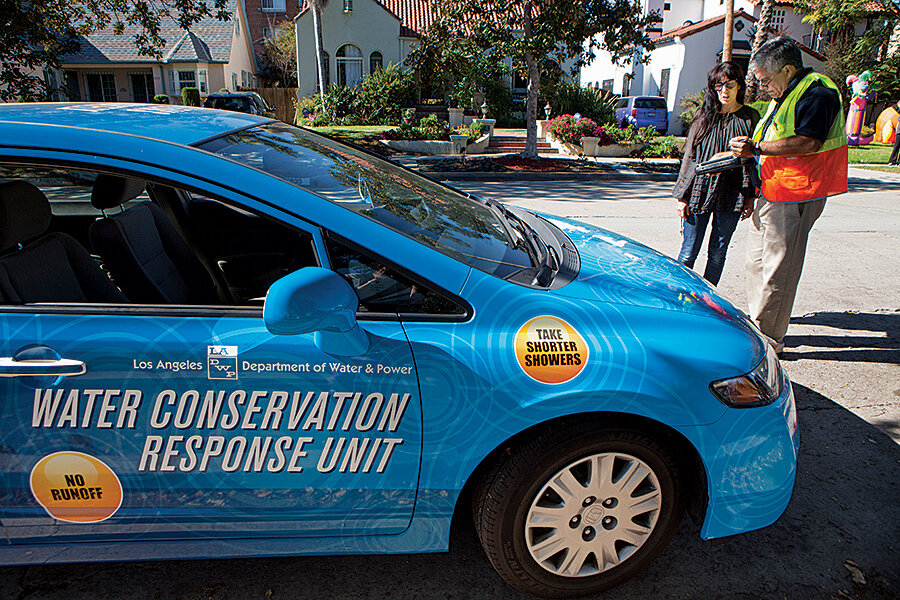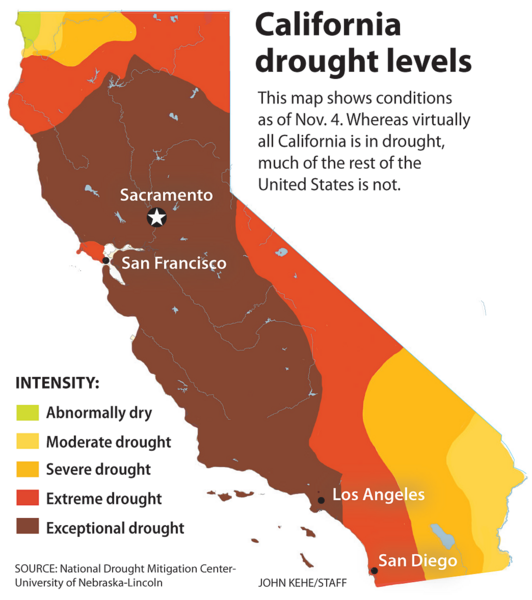Three years into drought, Californians adapt to a drier way of life
Loading...
| Los Angeles
When Rosemary Plano decided to rip out her lawn in 2012 and put in a low-maintenance desertscape of succulents, heather, and gravel, passersby said things like “it’s jarring” or “you’ll miss your roses.”
Now they are asking for a list of the plants she has, what kind of drip irrigation she uses, and how much money she’s saving.
“My neighbors on both sides want to do the same thing,” she says.
When Heidi Cuett, a student at California State University, Los Angeles, showed up at school with her dirt-caked Prius recently – with a sticker reading “Go Dirty for the Drought” – her professors cleared time for her to tell classes about it. Now about 20 to 30 percent of her classmates have signed up for the two-month pledge, she says.
“It’s a really filthy community,” she says with a laugh, noting the “dry lake bed” look of the top of her black car. “But it’s a tightknit community with a commitment to significantly reduce water waste. People see the sticker and realize I’m doing it on purpose for a cause, and they immediately want to follow suit.”
Three years into a historic drought in California, with 2013 being the driest year on record for the state, stories like the ones above are proliferating. They point to the fact that Californians are finally turning their concern about the drought into changed behavior.
“I think people are just taking it more seriously,” says John Moore, an insurance salesman from Sherman Oaks. “I see the sign on the highway, ‘Serious drought: [help] save water,’ and so I turn off the water when I’m shaving. I read about farmers fallowing their fields, and something in me just says, ‘Take a shorter shower.’ ”
The stakes have been high. California is the producer of half of America’s fruits, vegetables, and nuts. Moreover, an already-costly wildfire situation has been getting worse, with the dry conditions sparking more fires and extending the fire season to year-round.
And so the drought has been the biggest story in California in 2014. In January, Democratic Gov. Jerry Brown declared a drought emergency and urged people to reduce their water use by 20 percent.
Later that month, California officials announced they were cutting off the flow of water from the northern part of the state to the south for the first time in the 54-year history of the State Water Project. That meant SWP customers – primarily in water districts that serve about 25 million people total and irrigate about 750,000 acres of farmland – would have to rely on other sources for their water.
To meet the challenges, statewide water forums have been held, with the major players – including farmers, environmentalists, and city officials – gathered uncomfortably in the same room. Smaller meetings have been held as well. And the conversation has reached Washington, where each chamber of Congress has passed its own version of legislation.
President Obama also got involved, announcing during a February visit to the state that his fiscal 2015 budget would include a $1 billion Climate Resilience Fund.
But despite such moves, a May water report found that usage in the state had actually increased by 1 percent.
Since then, however, the word has gotten out, and citizens are stepping up. Helping the cause are mandatory restrictions on outdoor water use that have kicked in – which come with $500 fines for activities such as overwatering lawns or using water to clean driveways.
Now, the numbers are closer to what Governor Brown called for. This September, water usage went down by 10.3 percent in comparison with September 2013, according to the State Water Resources Control Board. The August conservation rate was even better – 11.6 percent – which prompted some concerns that since then residents’ efforts have slackened a bit.
Still, both the August and September figures (the most recent data available) show substantial improvement over readings for earlier months. According to the board, 27.6 billion gallons of water were saved in August and 22 billion gallons in September.
Californians also demonstrated a commitment to addressing the state’s water issues by passing Proposition 1 on Election Day. The measure designates more than $7 billion for water conservation and recycling, water supply projects, ground-water cleanup, and river restoration.
For residents thinking about making changes to water usage at home, there are incentives to help them along.
The Los Angeles Department of Water and Power (LADWP) has increased the rebate for ripping out a traditional grass lawn and replacing it with drought-tolerant California flora from $2 to $3 per square foot to $3.75 now – one of the highest such rebates in the state.
Landscapers are reporting a huge rush.
“Being environmentally appropriate is no longer fringe: It’s just being appropriate to where you live,” says Kitty Connolly, executive director of the Theodore Payne Foundation (TPF), an organization in Sun Valley, Calif., that promotes cultivating landscapes native to the state. “Our gardening tradition has long been keyed to England and New England, so this adjustment is a big cultural change.”
Now, TPF’s basic landscaping classes sell out regularly, and their sales of native plants – from several kinds of manzanita to narrow-leaf milkweed to sand dune sedge – went up 23 percent between 2011 and 2013.
“That’s indication of the demand,” Ms. Connolly says. “We have the media to thank for that. They’ve been all over this drought.”
Connolly is excited that many immigrants have decided to go with the change in landscape upon arriving. In fact, she sees immigrants – a key group in California – as playing an important part in the changes.
“Most usually adopt the customs of where they immigrate to, so the fact that they are adopting low-use landscapes is most impressive,” Connolly says. “It means their kids won’t have to change the premise later.”
She points to Sunny Zhang and Roger Hsu, who moved to Northridge, Calif., five years ago from China. They converted their landscape to 70 percent California plants and then bought and converted the neighboring property as well. They also did the landscaping for Mr. Hsu’s father.
“I never had a lawn, so I don’t know how much I’m saving,” Ms. Zhang says, “but whenever I show my bill to others, they say [mine is] very cheap.” She says she waters the plants about once a week, but sometimes less often – even once a month.
She says they got a $4,000 rebate on their first lawn replacement and, after the LADWP upped its rebate, more than $7,000 on the third.
Homeowners also got some help from the state’s biggest newspaper, the Los Angeles Times, which published a 52-page special section with articles and tips on installing low-flow faucets and using rain barrels, for example. The report also broke down water use statistics to show where possible waste and savings could occur for homeowners.
Environmental groups are encouraged by what they’re seeing.
“Californians can and are using less and are realizing a huge potential to do even more in the future,” says Doug Obegi, a staff attorney in San Francisco for the Natural Resources Defense Council’s water program. He says his organization’s polling “shows there is a growing willingness to sacrifice for the drought, from improving efficiency and water recycling to rationing.”
Businesses also have been stepping up to the plate and making changes. Anheuser-Busch in Los Angeles, for example, has adopted plastic conveyor belts that reduce the amount of water needed for lubrication. Other businesses are converting their green lawns into drought-tolerant landscapes.
Not everyone is on board with the efforts.
“Two of my neighbors stopped by to nudge me for watering my lawn every night at 9 p.m. and leaving a little trickle of water in the gutter,” says a man who lives up the street from Ms. Plano in Sherman Oaks and asked not to be identified. “They said they were trying to save me from getting a fine, but it was an awkward moment.”
Across the street from him lives retired psychologist Clarann Goldring, who is known around the neighborhood for the explosion of colorful flowers she prunes meticulously in her front yard.
“I have a beautiful garden that I can’t water as much as I would like, and my roses are no longer doing as well as they should,” she says. “I understand that I have to cut back because there isn’t any water. Maybe I will put in a fake lawn that doesn’t need any water.”
Her husband, Irv Goldring, says the Central Valley farmers should get priority, “because even though we’re all in this together, they feed us. If our lawn dies, whatever....”
Yet Central Valley farmer John Harris, whose family has been farming in Coalinga, Calif., since 1937, has noticed only small changes by residents.
“I think Californians have somewhat changed their behavior,” he says in an e-mail, but then adds, “we can’t solve our lack of adequate irrigation water just from more cautious behavior on the part of consumers.”
He and other farmers have felt the squeeze from environmental groups, which the farmers see as irked that 75 to 80 percent of California water goes to farms.
“What the environmental community really wants is for all of us to lower our expectations on ever getting adequate water to benefit all – never build reservoirs or dam rivers or expand existing dams,” Mr. Harris writes.
Some in the environmental community, for their part, have singled out for criticism Lake Mission Viejo – a 1.2-billion-gallon reservoir surrounded by upscale homes that was established in Orange County in 1977.
Creating a “giant swimming pool for the few” with a public resource “makes no sense at all,” Conner Everts, co-facilitator of the California Environmental Water Caucus, told the L.A. Times.
“We have these inequities across the state, and this exemplifies water abuse,” Mr. Everts said. “You want lakes? Move to Minnesota.”
But overall, many experts see considerable change.
“When you think about 38 million Californians, it sometimes seems like steering a huge oil tanker, but when public policy makers and media finally focus on it, it can finally come together – and has,” Richard Frank, professor of environmental practice at the University of California, Davis, writes in an e-mail.
“People are responding to this through social media,” adds Rachel Stich, communications director for LA Waterkeeper, which created the #DirtyCarPledge.
The organization calculates that if 10,000 southern Californians who normally wash their cars every two weeks took the two-month pledge, 3 million gallons of water would be saved.
While that’s not nearly the savings of a landscape make-over, the program has been very valuable because of the awareness it’s raised.
“The idea of this was to get people talking about the drought,” says Ms. Stich. “Now people tell us that even if they don’t want to leave their car filthy, they’re ready to take shorter showers or get a low-flush toilet.”
• Staff writer Gloria Goodale contributed to this report.








